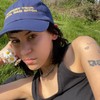Illustration: Christa Jarrold
“Who is that?” I remember thinking to myself when Attitude magazine unveiled one of the covers for their September 2020 issue. It was someone in a white tee, arms bent behind their head to reveal a glimmer of armpit hair, dark fringe flopped over swooping cheekbones. It was, I quickly realised, Deaken Bluman, a straight male actor who appears in hit teen show 13 Reasons Why. But that didn’t make much difference to me, a queer woman. I was too busy being enamoured with this glowering soft butch.Lesbians being into guys – not sexually per se, but vibe wise – is nothing new. When James Dean rose to prominence in the 1950s, he embodied a kind of brooding masculinity that a lot of lesbian women could see themselves in. Queer scholar Marie Carter, in a 2003 essay, went as far to say that Dean emulated a certain post-World War II masculinity propegated by butch women at the time: white tee and work boots, cigarette hanging moodily between two lips, the perfect image of dyke camp.“I argue that the 1950s ‘new man’ is based partly on butch identity, and that the butch-femme construct had a strong impact on contemporary culture as a whole,” she wrote. Dean’s soft butchness was a way of expressing his queerness stylistically in a way that was safe while still transgressive, she says. In other words, it wasn’t lesbians who were trying to look like Dean, but the other way round, and then they in turn imitated him. A neat cultural circle.We can still see the lesbian-male style continuum in action today. In a piece for Teen Vogue, Emma Madden cites contemporary heartthrobs like Harry Styles, Timothee Chalamet and Justin Bieber as being sort-of lesbian icons (the latter, she points out, is the subject of the blog Lesbians Who Look Like Justin Bieber). It’s hard to pinpoint what it is about these men – their casual androgyny, perhaps, their soft dykey style (suits, vests, one dangling silver earring) – but there’s no denying that lesbians are drawn to certain men more than others.“I can’t tell if I have a crush on Harry Styles or I just want to look like him,” wonders 24-year-old lesbian Rhiannon. “It’s hard to explain. On the one hand, I can’t stop looking at him from that era in One Direction where he was wearing all black and headbands and started getting tattoos. But on the other, it’s like: that’s just what the lesbians I fancy wear. And also what I like to wear myself. It’s the same with Cole Sprouse!”Some lesbians I speak to might not agree that men can be lesbian style icons, per se, but that they’re drawn to certain men for other reasons. “I think Frank Ocean has a huge lesbian following because his music is romantic and emotional in this very specific way,” says 25-year-old Anna. “Same with Bon Iver. What can I say? I guess we love getting in our feelings. Anything about yearning and unrequited love especially. They’ve got a gay following but also a lesbian one for the same reasons.”Twenty-eight—year-old lesbian Franks thinks that men can be lesbian icons, but only when we say so ourselves. It’s tongue-in-cheek when we crown them “dykons”, and straight up annoying when it comes from the outside. “I think there’s an acknowledgement that men don’t really massively contribute to lesbian culture, so when someone like Hozier is called a ‘dykon’ it’s an in-joke,” she explains. “But if straight people started being like, ‘Omg, yas, Harry Styles is a butch stud’ we’d be like ‘STFU’. There’s a line there which needs to be treaded carefully.”I know what Franks is getting at, and it’s this, I think, which sits at the heart of why lesbians crown certain men dykons. We know it’s ridiculous. That’s why it works. In 2018, Natalie Adler wrote a brilliant piece about Bruce Springsteen – the totem of straight maleness – being like a butch lesbian mom to her. There’s something quite queer, she said, about seeing queerness in the straightest of things. “There is a disarming, queer playfulness in the art of labelling straight men as lesbians in disguise. It’s a statement of protest that masculinity doesn’t belong to cis men.”@daisythejones / @christajarrold.art
Advertisement
Carter isn’t the only one to argue that lesbians influence men who then influence lesbians in this way – it’s an old hypothesis. “I have this theory that lesbians start certain fashion things,'” Stephanie Perdomo, the creator of Dykedolls action figures, told the New York Times in 2004. “I used to go around Williamsburg and see guys wearing wifebeaters, wallet chains, gas station shirts and trucker hats, and I would think, 'We used to do that five years ago.’”
Advertisement
While a lot of lesbians online wryly dub certain men “dykons,” a lot of others bristle at the idea. “Society worships cis guys, especially skinny white guys. They genuinely have to do the bare minimum,” says 26-year-old lesbian Kai. “I’d rather iconise actual dykes and butch women style icons. Timothee Chalamet is intensely boring to me as a lesbian.”Others say similar things. “I get that gay men have always looked up to women like Cher and Madonna etc, but this feels different because these so-called ‘male lesbian icons’ are also symbols of straight culture which I don’t want to be part of,” says 24-year-old Rosie. “It reminds me of when I was like 15 and pretending to fancy guys in bands when really I was a raging lez who was more interested in Hayley Williams. I’ve left those days behind me and have no intention of resurrecting them.”
Advertisement
